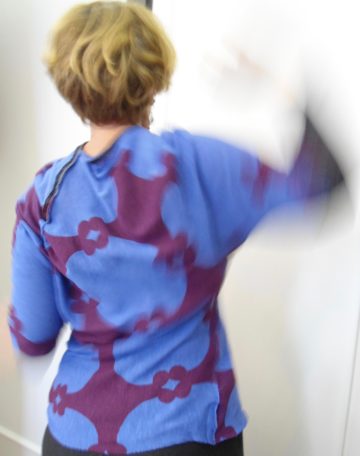
Wie ben je? Mijn naam is Dorothy Wedderburn. Brits en sinds een jaar een gelukkig Nederlander.
Waar kom je vandaan / waar ben je geboren? Ik ben geboren in het noorden van Nigeria. Waar ik eigenlijk vandaan kom is moeilijker te beantwoorden – mijn leven is behoorlijk nomadisch geweest. In mijn jeugd pendelde ik tussen Nigeria en Engeland. Daarna ben ik een aantal jaren in Londen gebleven voordat ik weer in verschillende andere landen in het buitenland woonde. Sinds 1991 woon ik in Nederland. Ik denk dat je gewoon zou kunnen zeggen dat ik een wereldburger ben.
Wat maak je en hoe maak je het? 
Voor Zône maak ik voornamelijk draagbare kunst zoals jassen en tops. Maar ik maak ook kunstwerken, die ik ‘hangings’ noem, voor aan de muur. Alles wat ik maak is uniek en individueel. Mijn materialen zijn oude kledingstukken en stoffen die ik in tweedehandswinkels en op brocantemarkten vind, of die aan mij worden gegeven. Deze combineer ik met nieuwe duurzame stoffen zoals bamboe, ecologisch katoen, tencel en resten die anders naar de vuilstort zouden worden gebracht. In alle stoffen zit de betekenis van een verhaal, van hoe/ wie/ waar het is geproduceerd. En als ik een voorgedragen kledingstuk uit elkaar haal, voel ik me bijna een archeoloog, ik kan de geschiedenis ervan echt voelen. Voordat ik bijvoorbeeld een nieuwe jas maak, laat ik de oude een tijdje op de paspop zitten, op de een of andere manier ‘spreekt’ het tegen mij en laat me weten wat ik moet doen. Als ik daadwerkelijk begin met creëren, heb ik altijd een idee van het eindstuk, maar ik laat me leiden door het daadwerkelijke proces … snijden, naaien, verven en zeefdrukken. In elke fase kan er iets onverwachts gebeuren dat me in een andere richting kan sturen. Dat is het deel waar ik echt van hou. Op de een of andere manier heb je een gesprek met je werk.
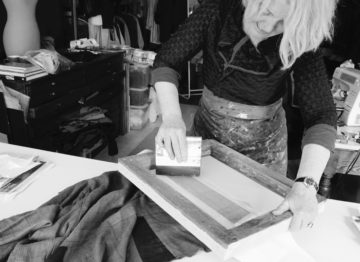
Hoe ben je op dit pad terecht gekomen? Ik ben altijd aangetrokken geweest tot stof, wat ik geweldig vind vanwege zijn tactiele eigenschappen. Mijn moeder maakte de meeste van haar eigen kleding en die van mij, en toen ik 5 was, kreeg ik van een tante een miniatuurnaaimachine. Het werkte echt en ik kopieerde mijn moeder en maakte kleding voor mijn poppen. Ik denk dat mijn pad voorbestemd was.
Wat is je opleiding? Op school leerden we de basis van kleding maken. En daar had ik ook een inspirerende tekenleraar die me kennis liet maken met zeefdruk en me meenam met winkelen om geschikte stof te kopen om op te printen. Ze vertelde me over kunstacademies en hielp me om een portfolio samen te stellen. Dus ging ik mode en textiel studeren aan het Ravensbourne College of Art and Design, in London. In die tijd was het net verhuisd naar een nieuw pand en was het prachtig uitgerust met een lange printtafel, een verfruimte, een stoomkoker, warmterollers, enz…. plus een heel goede technicus.
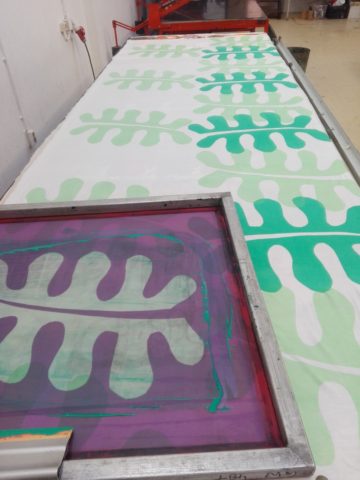
Wat inspireert jou? Inspiratie komt overal vandaan. Kunst, architectuur, wat mensen dragen, maar ook van meer vluchtige dingen zoals schaduwen en reflecties. En natuurlijk is de natuur eindeloos inspirerend in haar patronen, kleuren en texturen.
Doet u nog ander betaald of onbetaald werk? Ik heb geluk gehad dat ik mijn hele leven met textiel heb gewerkt: in kleinschalige drukkerijen, als ontwerper, als adviseur en als leraar. Meestal kon ik ook doorgaan met het maken van mijn eigen werk en de afgelopen 7 of 8 jaar heb ik enkel eigen werk gedaan. Het kost me veel tijd omdat ik immers alles zelf doe.
Hoe ben je lid geworden van zone? Ik gaf les aan Het Koorenhuis in Den Haag en een collega, Martine Knoppert, een toenmalig lid van Zone, vroeg me of ik interesse had om mee te doen. Aanvankelijk dacht dat ik niet graag deel uit te willen maken van een groep. Maar ik mocht wat werk in de galerie aanbieden en verkopen. Het in contact komen met de andere leden overtuigde me ervan dat ik het eens moest proberen. Dat was 13 jaar geleden en ik heb niet achterom gekeken! Ik heb er nooit spijt van gehad.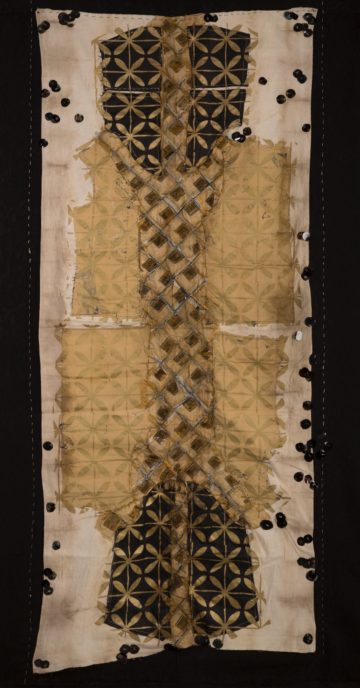
Wil je nog iets anders zeggen? Deel uitmaken van de Zone ‘groep’ heeft me zoveel gegeven. Dankzij de galerie heb je een vaste plek om je werk tentoon te stellen en zo een klantenkring op te bouwen. En het geeft je de vrijheid en mogelijkheid om van alles te doen: klanten ontmoeten; tentoonstellingen organiseren; deelname aan tentoonstellingen. De interactie met bezoekers is belangrijk. Er komen zoveel verschillende mensen naar de galerie om te kijken, praten en kopen, en ze komen steeds weer terug. Je collega’s zijn klankbord voor je werk en ideeën, en we delen ook de meer alledaagse taken van het runnen van de galerij. Dankzij onze gezamenlijke inspanningen en de steun van trouwe klanten en de lokale gemeenschap hebben we vorig jaar genoeg geld kunnen inzamelen voor een hypotheek om de galerieruimte te kunnen kopen. Met de 30e verjaardag van Zone op komst, voelt dat goed.
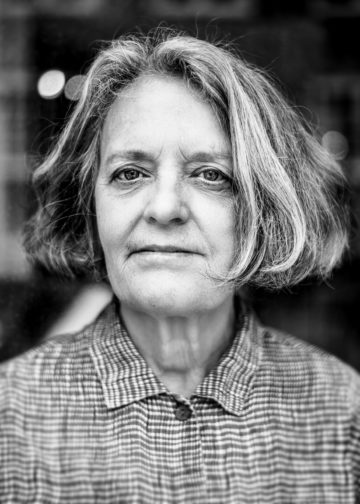
Lang leve Zone!
